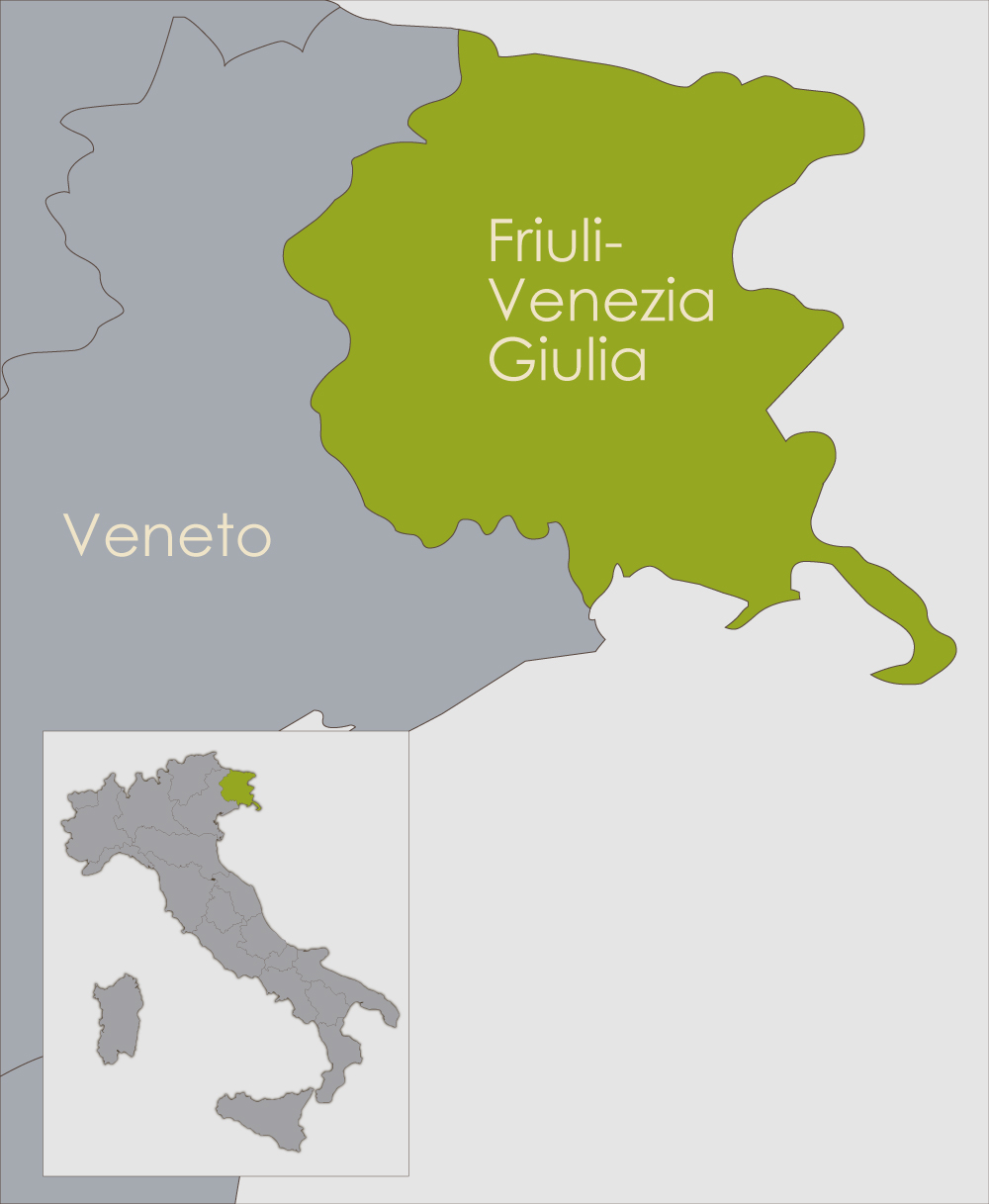 |
FAST FACTS
PRODUCERS MARCO FELLUGA, RUSSIZ SUPERIORE |
OVERVIEW
Friuli–Venezia Giulia is the easternmost region of northern Italy, bordering Slovenia on the east, Austria on the north, the Adriatic Sea on the south, and Veneto on the west. It comprises two geographical areas: Friuli, which makes up most of the region, and Venezia Giulia, a small sliver of land along the Adriatic coast between Friuli and the city of Trieste. Because Friuli is far larger than Venezia Giulia, the entire region is frequently called simply Friuli. Both areas are named after Julius Caesar; Friuli is a contraction of Forum Iulii (Julius’s Forum), and Giulia is another form of Julius (Venezia Giulia = Julian Venice).
History: Northeastern Italy has a very long history as a frontier region between cultures that were perennially at war. The boundary between what we might think of as Italy on one side and Austrian or Slavic territory on the other moved back and forth over the centuries—sometimes separating Friuli and Venezia Giulia, and other times having both united on one side or the other (Venezia Giulia historically refers to a more substantial area that includes parts of Austria, Croatia, and Slovenia).
Modern-day Friuli–Venezia Giulia, Veneto, and Trentino–Alto Adige were part of a single administrative unit of the Roman Empire. Afterward, Friuli and Venezia Giulia were ruled by Lombards, Franks, and the Holy Roman Emperor. In the early 15th century, the maritime Republic of Venice extended its control inland, including Friuli, but not Venezia Giulia. After the Napoleonic wars at the end of the 18th century, most of Friuli ended up as part of the Kingdom of Lombardy-Venetia under the Austrian Empire for more than 50 years, until that kingdom broke away and joined the new Kingdom of Italy. Austria retained control of Venezia Giulia and the province of Gorizia, however.
Friuli–Venezia Giulia was thus on the front lines of World War I between Italy and Austria, and it suffered greatly in the fighting. Many inhabitants and soldiers were killed, and the battles also destroyed a lot of vineyard land. After that war, Italy annexed the city of Trieste and land connecting it to the rest of Italy, along with the Gorizia area, from defeated Austria. At that point, Friuli–Venezia Giulia was essentially complete as we know it today. The fighting was not complete, however, as further battles were fought between the Italians and Yugoslavia during World War II, adding to the damage of agricultural land.
In the second half of the 20th century, Friuli–Venezia Giulia underwent a renaissance, rebuilding a modern agricultural base alongside industrial and technological businesses. The region is now among the strongest in Italy economically.
Geography: Friuli–Venezia Giulia is a small region in Italy’s northeast. The northern half is mountainous, with Alpine peaks reaching 9,000 feet (2,750 m), so viticulture is practiced primarily in the southern half. Here, mostly flat plains slope gently down to marshes on the Adriatic coast in the south. Hills line the eastern border with Slovenia, providing some of Friuli’s best vineyard land.
Climate: Friuli–Venezia Giulia has some of the northernmost vineyards of Italy, yet it is also on the Adriatic Sea, so its climate is cool but not as challenging for vines as in regions located farther from the coast. The mildest climate in the region is found in Venezia Giulia, which has the maritime influence to keep temperatures cool in summer, while the Slovenian mountains protect it from the coldest winter winds. The plains are less protected and therefore see somewhat larger temperature variations. Precipitation is ample and fairly evenly spread throughout the year.
Primary grape varieties: Because of the decades of destruction of vineyards—from phylloxera to mildew to the two world wars—the majority of Friuli–Venezia Giulia’s vines had to be replanted in the latter half of the 20th century. As a result, international varieties are more prominent here than in any other region. In particular, Pinot Grigio has been planted in a big way as that variety continues to be globally popular. Merlot, Chardonnay, Sauvignon Blanc, Cabernet Franc, and Cabernet Sauvignon are all near the top as well.
The most-planted indigenous variety is none other than the region’s namesake Friulano (formerly Tocai Friulano). Other well-represented native grapes include Refosco dal Peduncolo Rosso, Glera, Verduzzo, and Ribolla Gialla.
Key wine regions: The Friulian denominations of the greatest interest are clustered in the hilly country along the Slovenian border. Here, Collio DOC and Friuli Colli Orientali DOC are the primary denominations, both well known by sommeliers and wine aficionados for their full-bodies white wines in particular. Both also make fine red and sweet wines.
Commercially, the most important denominations are large ones such as Friuli DOC, which covers the southern half of Friuli–Venezia Giulia and produces several types of wine. There are also two bigger denominations that contain not only Friuli but also most or all of Veneto: Prosecco DOC and Delle Venezie DOC—the latter mainly for Pinot Grigio. At the less-restrictive quality wine level, IGP Venezia Giulia and IGP Trevenezie are the counterparts for Friuli DOC and Delle Venezie DOC, respectively.
Cuisine: The foods of Friuli–Venezia Giulia reflect the historical connections the region has with the Venetian, Austrian, Slovenian, and Croatian cultures. One example would be gnocchi (dumplings), which here are typically made with potatoes rather than wheat pasta. Dumplings are more common than spaghetti or tube-shaped pastas and appear in soups and desserts as well as main courses. Other dishes with central European roots include muset e brovada, basically turnip sauerkraut with pork sausage, and gulasch, a paprika-spiced beef-and-onion stew.
More obviously Italian dishes are plentiful, too. On a menu, expect to see some filled pastas, polenta, hearty soups, game, and near the coast, a wide variety of fish and shellfish. One of the most familiar products from Friuli is Prosciutto di San Daniele, a DOP-level cured ham that is usually served sliced thin for breakfast, as an appetizer, or perhaps wrapped around a white asparagus stalk. The most typical cheese is Montasio, a creamy cow’s-milk cheese that often appears in a frico, a fried wafer of cheese and often potato that is a typical meal starter. As a meal ender, look for streudel or gubana, a fruitcake with swirls of filling inside.

